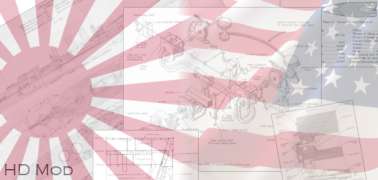First to say, AE is considered an excellent piece of research and organization
on a large scale pacific war simulation - a step above WITP where many factors
have been addressed, in particular the mechanics of air-to-air combat.
While the mechanics and overall performance of the air-to-air action are correct,
the RELATIVE performances of the air-to-air devices are not correct.
The primary difficulty is with the RELATIVE accuracy and effectiveness.
First the accuracy of the 12.7 weapons is less than it should be, as is the
relative accuracy. Historically USN 50 caliber ammo was 450 rounds for the F4F-3 and 500 rounds for the P-38,
much more than the 200 rounds for a Ki-44, this disparity must be represented.
This does not need to be debated, let us just say I am an old dog of this subject and my views are based on first hand accounts and not the 70 years of confabulation and conjecture of writing since about the subject.
The accuracy of the A6M2 is much too high at 22. An ammo supply of 60 rounds and low muzzle velocity
will yield an accuracy closer to 4. The effect however needs to be increased, a 20mm round was devastating and was the primary armament of each air force except the US.
The problem with the zero's 20mm was that while a good attack position could be achieved by experienced pilots,
this could seldom be done by inexperienced pilots, while any decent attack position with a browning-6-pack could cause some damage. The result: early in the war the zero is sweeping the skies, by the time of the philipine sea
the disparity in pilots is large and the rookie pilots are not achieving attack positions on US fighters.
Hence the large caliber cannon is an "all or nothing" affair. Whereas the 7.7mm could hit all day and cause no major damage (see Sakai's words about fighting the Wildcat)
The browning was retained in lieu of larger rounds for two reasons
1) it could fire a large number of rounds before jamming
2) it could fire a large number of rounds accurately which was ideal for the maneuverable planes facing them
*see battle of phillipine sea, some hellcat pilots bring down several japanese planes
the only difficulty was when facing the armoured japanese fighters such as the Ki-61 and Ki-84, or the Emily flying boat where the effect of the 50 caliber rounds was insufficient.
It is known that the formula for weapon accuracy is largely based on rate of fire, however this is considered a fallacy. In some services, such as the RAF, a large number of guns with little ammunition was used as per the doctrine of short bursts from close range. Other pilots preffered fewer guns with more ammo, so the path of the tracers could be used to adjust fire (see Jimmy Thatch complaining about the F4F-4 and its 6x240 rounds versus the F4F-3 with 4x450 "if you miss with 4, you miss with eight"
A new formula for these calculations for accuracy is proposed.
Accuracy = muzzle velocity (ft/s) x ammo supply x mounting (cowl =1, wing = 1/2)
_____________________ _____________
_ _ _ _ _ _ _ _ _ _3000_ _ _ _ _ _ _ _ 500
The 7.7mm effect is reduced to 1, the 7.7mm range is increased to 400
The 12.7mm effect is reduced to 2, the 12.7mm range is increased to 500
The 20mm effect is increased to 5, the 20mm range remains at 500
The 30mm effect is increased to 8, the 30mm range is 500
The 37mm effect is increased to 10, the 37mm range is 500
reliability and rate of fire was already taken into consideration when the ammo supply was fitted,
500 rounds are carried by 7.7 of the zero since it is reliable with that amount, 200 rounds are fitted
to the Japanese 12.7 on the tony since that is reliable, 30 rounds of 37mm on the air cobra since that is the
amount that could be fired in a reasonable amount of time of an attack position, etc.
Images will follow (numbers beside devices are the ammo supply)











